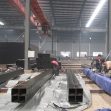Characters Of A Well-Designed Curtain Wall
Curtain walls are one of the most prominent features in modern buildings. They are placed on the surface of a building, forming a barrier between the interior and exterior of the building structure and acts as a protective shield. Its main purpose is to keep air and water out of the building and is subjected to weathering action like wind, sunshine, frost, etc.

In practical applications, curtain wall systems are typically designed with extruded aluminium framing members, although the first curtain walls were made with steel frames. Glass curtain wall systems are extensively used in modern construction, which are typically in-filled with glass, providing an architecturally pleasing building, offering effective day lighting and reducing solar radiation. Generally speaking, any good curtain wall construction is not supposed to be an afterthought, it should be an integral part of the design. And a well-designed curtain wall should be coordinated with the structural grid of the building whereby every micro aspect, such as vertical and horizontal divisions, size of panels, junction details, termination details at roof top and bottom level, etc. are well addressed.
In the modern society, curtain wall facades are widely used in high-rise buildings. Considering technical, functional and visual aspects, a well resolved design, properly detailed at all interfaces, is able to implement with good quality and finishes. Structurally robust designs of curtain walls use a fewer materials, yet offer good structural strength with optimised engineering designs. Furthermore, in the course of designing and installing curtain wall systems, a few principal considerations have to be taken into account, including performance, appearance and economy. Specifically speaking, in curtain wall systems, these requirements are closely connected to the form and the position of the supporting metal structure and anchoring system to the building frame. Although these systems are secondary structures of the building, they have to be effectively designed to safely resist the variable actions of wind and thermal loads acting on the building facades. In addition, any other load combination case, such as seismic action, should be meticulously considered to maximise the structural safety and minimise any hazards to humans.
In addition, a good curtain wall system does not carry the floor or roof loads of the building. The wind and gravity loads of the curtain wall are transferred to the curtain wall structure. In that regard, if you would like a well-designed curtain wall system with high-efficiency properties, the most important are a high strength-to-self-weight ratio, serviceability requirements, recyclability of the constituent parts as well as transparency and overall aesthetic characteristics.
Tel: +86 18202256900 Email: steel@fwssteel.com










